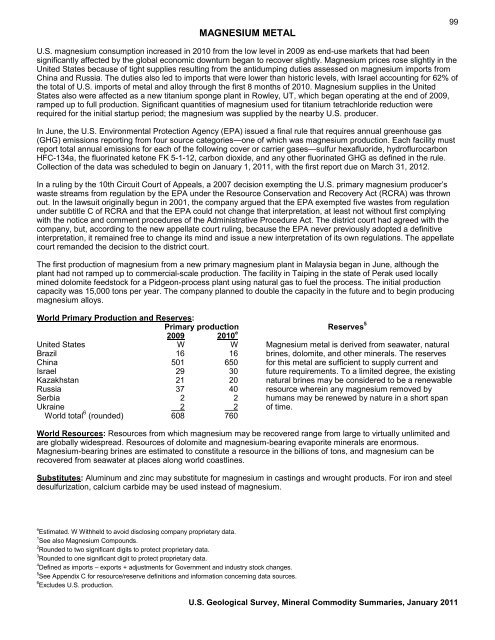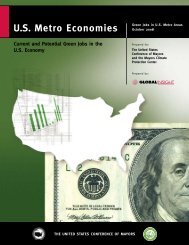Mineral Commodity Summaries 2011 - Environmental and Energy ...
Mineral Commodity Summaries 2011 - Environmental and Energy ...
Mineral Commodity Summaries 2011 - Environmental and Energy ...
Create successful ePaper yourself
Turn your PDF publications into a flip-book with our unique Google optimized e-Paper software.
MAGNESIUM METAL99U.S. magnesium consumption increased in 2010 from the low level in 2009 as end-use markets that had beensignificantly affected by the global economic downturn began to recover slightly. Magnesium prices rose slightly in theUnited States because of tight supplies resulting from the antidumping duties assessed on magnesium imports fromChina <strong>and</strong> Russia. The duties also led to imports that were lower than historic levels, with Israel accounting for 62% ofthe total of U.S. imports of metal <strong>and</strong> alloy through the first 8 months of 2010. Magnesium supplies in the UnitedStates also were affected as a new titanium sponge plant in Rowley, UT, which began operating at the end of 2009,ramped up to full production. Significant quantities of magnesium used for titanium tetrachloride reduction wererequired for the initial startup period; the magnesium was supplied by the nearby U.S. producer.In June, the U.S. <strong>Environmental</strong> Protection Agency (EPA) issued a final rule that requires annual greenhouse gas(GHG) emissions reporting from four source categories—one of which was magnesium production. Each facility mustreport total annual emissions for each of the following cover or carrier gases—sulfur hexafluoride, hydroflurocarbonHFC-134a, the fluorinated ketone FK 5-1-12, carbon dioxide, <strong>and</strong> any other fluorinated GHG as defined in the rule.Collection of the data was scheduled to begin on January 1, <strong>2011</strong>, with the first report due on March 31, 2012.In a ruling by the 10th Circuit Court of Appeals, a 2007 decision exempting the U.S. primary magnesium producer’swaste streams from regulation by the EPA under the Resource Conservation <strong>and</strong> Recovery Act (RCRA) was thrownout. In the lawsuit originally begun in 2001, the company argued that the EPA exempted five wastes from regulationunder subtitle C of RCRA <strong>and</strong> that the EPA could not change that interpretation, at least not without first complyingwith the notice <strong>and</strong> comment procedures of the Administrative Procedure Act. The district court had agreed with thecompany, but, according to the new appellate court ruling, because the EPA never previously adopted a definitiveinterpretation, it remained free to change its mind <strong>and</strong> issue a new interpretation of its own regulations. The appellatecourt rem<strong>and</strong>ed the decision to the district court.The first production of magnesium from a new primary magnesium plant in Malaysia began in June, although theplant had not ramped up to commercial-scale production. The facility in Taiping in the state of Perak used locallymined dolomite feedstock for a Pidgeon-process plant using natural gas to fuel the process. The initial productioncapacity was 15,000 tons per year. The company planned to double the capacity in the future <strong>and</strong> to begin producingmagnesium alloys.World Primary Production <strong>and</strong> Reserves:Primary production Reserves 52009 2010 eUnited States W W Magnesium metal is derived from seawater, naturalBrazil 16 16 brines, dolomite, <strong>and</strong> other minerals. The reservesChina 501 650 for this metal are sufficient to supply current <strong>and</strong>Israel 29 30 future requirements. To a limited degree, the existingKazakhstan 21 20 natural brines may be considered to be a renewableRussia 37 40 resource wherein any magnesium removed bySerbia 2 2 humans may be renewed by nature in a short spanUkraine 2 2 of time.World total 6 (rounded) 608 760World Resources: Resources from which magnesium may be recovered range from large to virtually unlimited <strong>and</strong>are globally widespread. Resources of dolomite <strong>and</strong> magnesium-bearing evaporite minerals are enormous.Magnesium-bearing brines are estimated to constitute a resource in the billions of tons, <strong>and</strong> magnesium can berecovered from seawater at places along world coastlines.Substitutes: Aluminum <strong>and</strong> zinc may substitute for magnesium in castings <strong>and</strong> wrought products. For iron <strong>and</strong> steeldesulfurization, calcium carbide may be used instead of magnesium.e Estimated. W Withheld to avoid disclosing company proprietary data.1 See also Magnesium Compounds.2 Rounded to two significant digits to protect proprietary data.3 Rounded to one significant digit to protect proprietary data.4 Defined as imports – exports + adjustments for Government <strong>and</strong> industry stock changes.5 See Appendix C for resource/reserve definitions <strong>and</strong> information concerning data sources.6 Excludes U.S. production.U.S. Geological Survey, <strong>Mineral</strong> <strong>Commodity</strong> <strong>Summaries</strong>, January <strong>2011</strong>







